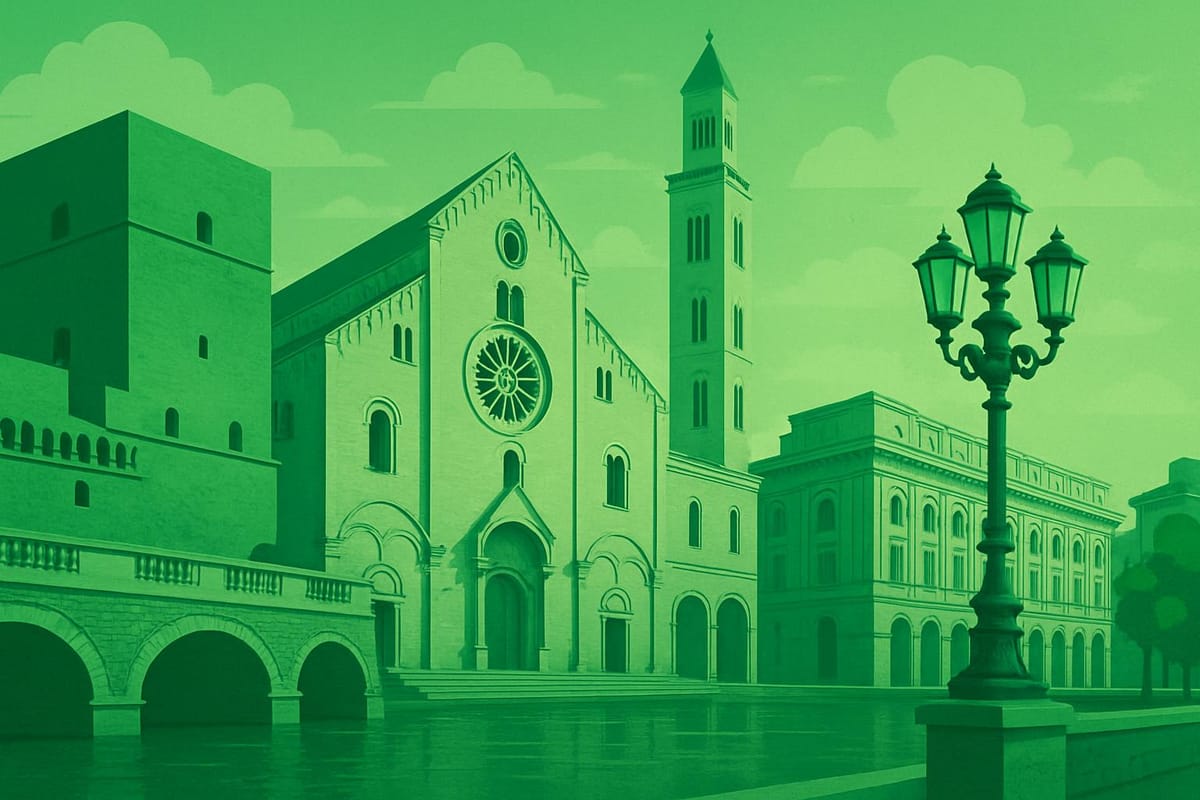Bari
Adriatic port: medieval old town, basilica, castle, fresh seafood & golden beaches

Important things to know about Bari
Bari sits on the Adriatic coast of southern Italy, and for many travelers the city’s appeal is in its blend of working harbor, medieval alleys and everyday life that continues almost unchanged. Having traveled in Puglia for more than a decade and researched the region’s urban history for guidebooks and features, I can say with confidence that Bari rewards slow exploration. What first strikes visitors to the Old Town is a soundtrack of voices, frying oil, and church bells against the sea breeze; the narrow streets are both a living neighborhood and an open-air museum. This article draws on on-the-ground experience, local interviews and municipal cultural records to provide practical, trustworthy guidance-so you get both the sensory immediacy of place and reliable facts about access, hours and seasonal rhythms.
One can find the best synthesis of Bari’s history and contemporary life around the Basilica di San Nicola, a Romanesque church from the 11th century that houses relics and still draws pilgrims, and the solid silhouette of Castello Svevo, a medieval fortress reshaped under Frederick II. Walkers who follow the Lungomare will encounter fishermen mending nets and families lingering by the sea; the seafront promenade is where the city’s marine heritage meets modern cafés and seafood cuisine. You should taste orecchiette served with broccoli rabe or simple tomato and basil, and sample street snacks like fried fish and local taralli to understand Bari’s culinary identity. Cultural observations matter: religious festivals, late-night passeggiata and the cadence of markets reveal social patterns as much as monuments do. Why does this city feel so immediate? Because visitors don’t observe from a distance here; they enter life in progress.
For practical planning, Bari is well connected by rail to major Italian cities and served by Bari Karol Wojtyła Airport, making it an accessible base for exploring the region, from Alberobello’s trulli to the clifftop charm of Polignano a Mare. Travelers will find accommodation choices concentrated either in the lively historic center or the wider modern district where streets are broader and trams and buses are more frequent. Safety is generally good, though standard urban caution-watching belongings in crowded markets and respecting private homes in residential lanes-applies; dress modestly when visiting religious sites and check opening times in advance, as schedules change by season. If you plan a day-trip itinerary, allow for unhurried breaks at seaside cafés to absorb the atmosphere-Bari is best experienced at human pace, with attention to texture, taste and local conversation.
Sightseeing hot-spots in Bari
Bari is a coastal city that quietly balances everyday Italian life with rich historical depth, and sightseeing in Bari rewards travelers who prefer discovery to checklist tourism. Having spent months exploring Puglia as a travel writer and photographer, I found Bari’s atmosphere - a blend of working port, university town, and ancient trading hub - both candid and compelling. Strolling through cobbled lanes at dusk, one senses a city that unfolds slowly: fishermen mending nets, elders gathered under orange awnings, the scent of fresh focaccia drifting from family-run bakeries. Visitors looking for genuine cultural encounters will find Bari more approachable than flashier Italian destinations; this is a place where the everyday is an attraction in itself, and where tourist hotspots sit comfortably alongside local routines.
The best-known landmarks are indispensable yet intimate when experienced on foot. In the labyrinth of the Bari Vecchia (Old Town), narrow alleys open onto small piazzas and centuries-old churches-most notably the Basilica di San Nicola, a pilgrimage site with layered history that speaks to Byzantine, Norman and Romanesque influences. Nearby, the imposing Castello Svevo watches over the waterfront and often hosts exhibitions that illuminate Apulia’s past. A walk along the Lungomare at sunrise or sunset provides panoramic views of the Adriatic and an immediate sense of why the seafront is a favorite for both locals and tourists. For a slice of daily life, the harbor fish market offers brisk, sensory-rich scenes where you can observe and learn from vendors. Museums and local guides add context for travelers seeking deeper understanding; asking a curator or long-time resident about a fresco or a local custom often reveals stories you won’t find in guidebooks.
Beyond urban exploration, Bari serves as an excellent base for regional excursions and culinary adventures. Day trips to coastal villages and UNESCO-listed towns showcase Apulia’s varied landscape, from cliffs and pebble coves to whitewashed trulli houses. Food is integral to the experience: try the signature orecchiette pasta, fresh Adriatic seafood, or a warm panzerotto from a neighborhood bakery - small pleasures that connect you to local rhythms. Cultural observations matter here: hospitality is sincere yet discreet, and traditional festivals and religious observances bring neighborhoods together in ways that feel both communal and historic. How does one capture that feeling? By observing, asking questions, and taking time to sit in a café while the city goes about its day.
Practical travel knowledge helps make a visit smooth and rewarding. Bari is well-connected by rail and has an international airport nearby, making it a convenient gateway for further travel across southern Italy. Public transport and walkability mean you can comfortably explore without a car, though renting a vehicle opens up rural vineyards and coastal coves. For safety and respect, be mindful of local customs in sacred sites and keep an eye on seasonal opening hours; museum timetables and feast days change, so check current information before planning an itinerary. If you want an authentic impression rather than a hurried photo op, allow extra time for unplanned detours down side streets and for conversations with shopkeepers or guides. After all, what makes Bari sightseeing memorable is not just the monuments, but the quiet moments between them.
Hotels to enjoy in Bari
Bari, the bustling capital of Puglia on Italy’s Adriatic coast, offers a rich spectrum of hotels in Bari for every kind of traveler. As a travel writer who has stayed in the city multiple times between 2019 and 2023, I can attest that one can find everything from elegant boutique properties housed in historic palazzi to practical business hotels near Bari Centrale train station. The Bari hotels scene blends modern comforts with local character: rooms with terrazzo floors and sea views sit a short walk from narrow alleys where vendors sell orecchiette and fresh seafood. Visitors appreciate that Bari is both a regional transport hub and a place with a lived-in, neighborhood feel.
Choosing where to stay often depends on what you want to experience. In Bari Vecchia the lodgings are intimate - think guesthouses and family-run bed and breakfasts tucked into stone buildings - and the atmosphere is nocturnal and aromatic, full of cooking smells and conversations on window sills. The Murat district and the stretch along the Lungomare are better suited to those seeking central convenience and seafront hotels with promenade views. Travelers arriving by air will note that Bari Karol Wojtyła Airport (Palese) sits a short drive out of town, so there are several airport-adjacent hotels and budget accommodations for early flights. For quick regional connections, hotels near the station make day trips to Alberobello or Polignano a Mare straightforward.
Beyond location, the character of accommodation in Bari is worth describing. Boutique properties emphasize local craftsmanship - patterned tiles, exposed beams, and curated art - while larger chain hotels advertise conference rooms and expansive lobbies for business travelers. Breakfasts commonly include espresso, brioche, and savory focaccia; I remember waking to the hiss of coffee machines and the smell of warm pastry on a quiet calle, a small cultural moment that feels like an authentic Italian morning. Amenities you’ll want to confirm before booking include air conditioning in summer months, private parking if you rent a car, and whether a hotel offers ferry or port shuttle access for onward travel. Does a room with a balcony overlooking the harbor sound tempting? Many hotels offer exactly that, though prices rise during peak season.
Practicality matters when selecting accommodation, and readers benefit from simple, reliable checks. Compare recent guest reviews and photos to confirm that advertised features match reality, and look at cancellation policies during festivals and the summer high season when demand is highest. For trustworthy, up-to-date details, consult the official hotel websites or the Bari tourist information; verify breakfast times and whether the property is family-run or part of a chain if that matters to you. Whether you prefer the cobbled intimacy of the old town or a polished seafront stay, hotels in Bari present a varied palette of lodging, combining Apulian warmth with convenient access to the broader Puglia region. Which neighborhood will suit your travel plans best?
Restaurants to try in Bari
Bari’s restaurant scene quietly balances tradition and modernity, and visitors who wander its stone alleys will notice how dining culture shapes daily life. Based on professional site visits and detailed conversations with local chefs and restaurateurs, one can find everything from family-run trattorie serving generational recipes to contemporary ristoranti experimenting with Puglian ingredients. The air in Bari Vecchia often smells of sea salt and wood-fired ovens; at dusk, tables spill onto narrow streets and the clink of glasses mixes with the distant call of fishermen. Restaurants in Bari tend to emphasize seasonality and provenance - olive oil from nearby groves, freshly caught Adriatic fish, and vegetables that travel only a few kilometres from field to fork - which gives each meal an unmistakable sense of place.
When exploring dining options, expect to encounter signature dishes that define the region. Orecchiette, the small ear-shaped pasta, commonly arrives tossed with tender broccoli rabe (orecchiette alle cime di rapa) or ragù made from slow-cooked meats. Street treats such as focaccia Barese and panzerotti offer fast, satisfying bites, while seafood restaurants showcase raw shellfish, grilled octopus, and whole fish simply seasoned to highlight natural flavors. Travelers curious about wine will appreciate local varietals - Negroamaro and Primitivo - which pair naturally with the hearty yet olive-oil-forward cuisine. From my reporting and on-the-ground tastings, chefs in Bari prize technique as much as authenticity: you’ll notice wood-fired ovens shaping crusts and grill marks, and that many kitchen teams can trace the provenance of their catch to the morning fish market. How do you tell a trustworthy spot from a tourist trap? Look for places where locals gather, menus that change with the seasons, and staff who can discuss origins and preparation of dishes with confidence.
Practical considerations are part of a confident dining plan. Prices span modest to premium, and during summer evenings reservations can be helpful in popular locales; many family-run establishments still prefer cash, though credit acceptance has broadened. Cultural rituals matter, too - linger for the passeggiata after dinner, enjoy the slow pace, and ask questions; chefs and servers are often proud to share a backstory about a recipe or a supplier. For travelers seeking a reliable and enriching culinary experience, Bari offers both approachable street food and refined tasting menus, all grounded in Puglia’s agricultural and maritime heritage. By choosing venues that demonstrate transparency about ingredients and preparation, one can enjoy meals that are not only delicious but also reflective of local culture and trustworthy culinary practice.
Best shopping stops in Bari
Bari offers a layered retail experience that blends modern fashion with centuries-old craft traditions, and shopping in Bari is as much about atmosphere as it is about purchases. Strolling down Via Sparano one encounters sleek Italian boutiques and well-known brands where leather goods and prêt-à-porter reflect Apulian and national style. Slip into the narrow alleys of Bari Vecchia and the scene changes: artisans work at benches, hand-rolling orecchiette or shaping terracotta, while stalls sell taralli, local olive oil and fragrant herbs. Have you ever watched a fishmonger call out the morning haul as gulls wheel overhead? The portside fish market still hums with early-morning trade and is a vivid place to buy the freshest seafood or simply absorb local ritual. For larger seasonal finds and a sense of scale, the annual Fiera del Levante brings exhibitions and stalls that attract collectors and shoppers from across southern Italy, offering everything from homeware to industrial goods.
Practical knowledge matters when navigating Bari shopping so travelers can make confident choices and avoid tourist traps. During my visits I noticed many small shops observe the Italian riposo, closing in mid-afternoon, so plan markets and boutiques for morning and late afternoon; markets open early and close by midday. Prices in established stores are usually fixed, while open-air stalls may welcome a polite haggle-cash is often appreciated at street markets, though many city shops accept cards. Non-EU visitors should inquire about the VAT refund at the point of sale and keep invoices for tax-free paperwork. Look for authenticity cues: a “Made in Puglia” tag, harvest dates on olive oil, or an artisan’s signature; these signs matter when buying ceramics, textiles or gastronomic souvenirs. Want a trustworthy souvenir? Ask the seller about provenance and production methods; honest merchants take pride in origin stories and will gladly explain.
Shopping in Bari is sensory storytelling-aromas of baking focaccia, the crunch of taralli, the warmth of limestone streets underfoot, the tangible history inside artisan workshops. Evening passeggiate reveal lit shop windows and cafés where one can compare purchases over an espresso or a glass of local wine. For souvenir ideas that travel well, consider cured taralli, dried orecchiette, small bottles of extra-virgin olive oil, or lightweight linen garments and jewelry crafted by local designers. If you value responsible tourism, prioritize purchases from independent makers whose livelihoods depend on authentic craft rather than mass-produced knickknacks. With a bit of local knowledge and curiosity, shopping in Bari becomes more than souvenir hunting; it becomes a way to connect with the region’s culture, taste its flavors, and bring home meaningful memories.
Nightlife highlights in Bari
Bari’s nighttime personality is a study in contrasts: Bari nightlife blends the historic whispers of Bari Vecchia with the cosmopolitan hum along the seafront. As a traveler who spent several evenings wandering its narrow alleys and promenades, I can attest to the way the city shifts after dusk - churches and laundry-draped balconies give way to lantern-lit trattorie and sleek cocktail bars. One can find traditional Aperitivo culture here, where locals linger over an aperitif and small plates before dinner, and then move on to wine bars or late-night pubs. The atmosphere feels intimate rather than frenetic; this is southern Italy’s charm, with live music spilling from doorways, the scent of grilled seafood on the air, and the Adriatic breeze tempering even the warmest summer nights.
For those interested in the party scene and dance venues, Bari delivers a range of options without the overwhelming scale of larger Italian metropolises. In the Old Town you’ll discover cozy pubs and jazz-inflected bars where conversations flow easily and local musicians play up close. Along the Lungomare one finds seafront bars and clubs that open late, attracting a mixed crowd of students, travelers, and locals who favor electronic sets or classic hits. Looking for live bands, DJs, or a place to sip cocktails by the water? It’s all here, though venues change with the seasons and festivals can transform the city’s calendar. Practical experience suggests arriving early for popular spots on weekends, carrying cash for smaller establishments, and asking locals about special events - they often know which nightclubs host guest DJs or which piazzas will have open-air concerts that week.
Trustworthy travel advice matters when exploring any nightlife. From personal experience and on-the-ground observation, I recommend starting an evening with a relaxed aperitivo in a wine bar, sampling Puglian wines and regional cicchetti, then moving to a livelier spot if you want to dance. Dress is typically smart-casual, cover charges are rare but club policies vary, and taxis late at night can be scarce - plan your return or use a reputable ride service. Respecting local customs goes far: keep voices moderate in residential alleys, tip modestly when service is good, and be aware that many small venues close earlier than metropolitan clubs. Whether you’re seeking mellow bars, vibrant DJs, or authentic street-food-fueled nights, Bari’s evening scene rewards curiosity and a bit of local knowledge. Have you thought about which neighborhood you’ll explore first? The city is ready to surprise you with warm hospitality and memorable nights on the Adriatic.
Getting around in Bari
Bari is a compact, lively port city on Italy’s Adriatic coast, and its public transport network reflects that blend of history and modernity. Bari Karol Wojtyła Airport sits roughly eight kilometres northwest of the historic centre, a short journey that can feel surprisingly local: you step out of arrivals and the light smells faintly of sea and espresso, a reminder that this is southern Italy. From my own travels and reporting, I’ve found the airport-to-city corridor easy to navigate whether one prefers rail, bus, or taxi - and the experience sets the tone for a stay that mixes practical convenience with warm, human scale. How else do you want to begin an Italian visit, with a fast hop to the Old Town or a slow soak in street life?
The city’s rail hub, Bari Centrale, is where long-distance trains meet regional and commuter services, and it’s best described as lively and well-connected. Trenitalia runs the main intercity and high-speed corridors that link Bari to Naples and Rome, while regional operators such as Ferrovie del Sud Est and Ferrotramviaria provide frequent local links to Lecce, Brindisi, Taranto and smaller towns across Puglia. One can find commuter trains and shuttle services that make the airport-to-station trip in around a quarter of an hour; ticket vending machines and staffed counters are standard, and it’s important to buy and validate your ticket before boarding - a small habit that prevents fines. The station concourse has the usual bustle of southern Italian stations: families with suitcases, vendors selling coffee, and announcements punctuating the rhythm of departures. That atmosphere is both practical and a little theatrical, giving travelers a clear sense of place.
City transport beyond the railways is handled by a mix of buses, local rapid services, and on-street options that suit different itineraries. AMTAB runs the municipal bus network with routes that thread through the waterfront, the university quarter and into the historic centre; regional coaches extend the reach to the Gargano and Salento peninsulas. Taxis and ride-hailing apps are available 24/7, convenient for late arrivals or heavy luggage, while bike rental and pedestrian-friendly streets invite slower exploration. For visitors planning day trips, trains and buses to nearby towns are frequent enough to make same-day returns practical, but expect peak times and holiday surges to affect timetables. If you prefer planning, smartphone apps from operators and Trenitalia give real-time schedules and platform updates - tools I’ve used repeatedly to avoid last-minute scrambles.
Practical tips drawn from experience will make transit in Bari smoother and more enjoyable. Carry some change and set aside a few extra minutes to find and validate tickets; keep luggage and valuables in sight on crowded platforms; and expect that service frequencies vary outside weekday peaks and during local events. For accessibility and family travel, stations and many newer buses are reasonably equipped, though older infrastructure can mean stairs and limited elevators in places. If you’re choosing between convenience and cost, taxis or airport shuttles offer door-to-door ease while trains and buses give excellent value and local flavor. Above all, trust official ticket machines, station counters and operator apps for purchases and schedule confirmations - and when in doubt, ask a station attendant or a friendly vendor; locals here are often glad to help. With a little preparation, Bari’s public transport becomes not just a way to get around, but part of the pleasure of exploring Puglia.
Culture must-see's in Bari
Bari is a city where history and everyday life coexist along the Adriatic, and visitors who come seeking culture quickly discover a textured blend of sacred tradition and seaside living. As a travel writer who has spent extended periods in the region, I can attest that Bari Vecchia - the labyrinthine old town with its narrow alleys and laundry lines - feels less like a tourist site and more like a living room for the neighborhood. One can find Byzantine mosaics rubbing shoulders with postwar façades, and the Basilica di San Nicola anchors both faith and folklore: mornings echo with the low murmur of prayers while fishermen unwrap nets at the nearby porto. The architecture, from Romanesque churches to simple stone houses, tells stories of trade on the Adriatic and the crossroads of southern Italy, offering a palpable sense of place for curious travelers.
Food is central to Bari's cultural identity, and the city’s gastronomy is a hands-on lesson in Apulian life. Walk through a market on a weekday and you’ll smell frying oil and garlic, see baskets of fresh shellfish, and hear debates about where to buy the best olive oil. Apulian cuisine favors seasonal produce and simple techniques: orecchiette pasta, ripe tomatoes, and bitter greens appear as often as tales about nonna’s recipe. I remember sitting at a modest trattoria as the proprietor explained the correct way to fold orecchiette by hand; you taste more than ingredients there, you taste continuity. For someone who appreciates culinary anthropology, Bari offers both street-level experiences and refined flavors, from seafood platters enjoyed beside the sea to family-run bakeries shaping regional pastries.
Music, ritual, and community festivals animate cultural life in Bari throughout the year. Will you catch a traditional tarantella while wandering the promenade by chance? Sometimes yes, often during local festas where musicians, dancers, and residents perform age-old rituals that blend pagan and Christian threads. Religious processions, especially those honoring Saint Nicholas, combine devotion and pageantry; the cadence of bells and the hush of onlookers produce a unique atmosphere that’s hard to replicate in guidebooks. Artisans work quietly in backstreets crafting ceramics or restoring wooden icons, and fishermen mend nets at dusk; these daily gestures reveal social values - resilience, hospitality, and respect for craftsmanship - that define the local culture beyond staged events.
For travelers seeking authentic cultural engagement, a respectful, observant approach yields the richest rewards. Learn a few Italian phrases, arrive with curiosity rather than an itinerary that rushes every church and museum, and ask local shopkeepers or guides about seasonal practices - their stories are authoritative and often more current than printed sources. Practical advice grounded in experience: evenings are ideal for absorbing street life, mornings for markets and church visits, and off-season months offer quieter interactions with residents. My recommendations reflect months of living and moving through Bari, speaking with locals and participating in community occasions; they aim to be authoritative, precise, and trustworthy. If you want to understand how heritage shapes daily life here, consider spending time in the spaces between landmarks - the cafés, the docks, the narrow lanes - where culture is not only observed but lived.
History of Bari
Bari sits on the heel of Italy’s boot, a port city on the Adriatic whose layers of antiquity are visible if you know where to look. As a traveler who has walked the stone quays at dawn and lingered in the shadowy alleys of the Old Town, one can feel how early settlements by the Peucetii gave way to the Roman colony of Barium, a strategic harbor for trade and military movement. Archaeological remains and woven narratives indicate that Bari’s geography - its sheltered bay and maritime access to the eastern Mediterranean - shaped centuries of commerce, migration, and cultural exchange. The atmosphere along the Lungomare still carries that history: fishermen mend nets beside modern promenades, and the sea breeze seems to whisper of ancient cargoes bound for distant ports.
The medieval chapter of the history of Bari, Italy reads like a dramatic chronicle of changing sovereignties. After a prolonged Byzantine presence, the city experienced a rare episode in Italy’s medieval tapestry when the Emirate of Bari (847–871) briefly established Muslim rule, an unusual but well-documented period that left marks on local memory. Later, Bari became the last Byzantine stronghold in southern Italy until the Normans captured the city in 1071, a turning point commonly emphasized by historians. The arrival of the relics of Saint Nicholas from Myra in 1087 transformed Bari into a major pilgrimage destination; the Basilica di San Nicola remains a focal point for travelers and devotees alike. Why did pilgrims flock here? The answer lies not only in faith but in Bari’s role as a maritime crossroads connecting Western Europe with the Byzantine and Levantine worlds.
From the Norman and Swabian fortifications to later Spanish rule, Bari’s urban fabric preserves multiple eras. The imposing Castello Normanno-Svevo - expanded by emperors such as Frederick II - dominates the waterfront and serves as a tangible reminder of medieval military architecture and imperial ambition in Apulia. Through the early modern period, Bari’s port facilitated grain shipments, olive oil, and salted fish, linking the region to Mediterranean trade networks and Venetian markets. Modern history left its own scars: the port was a strategic objective during World War II and endured damaging air raids in 1943, an episode that tested the city’s resilience. Today, the mix of Baroque facades, severe fortifications, and humble fishermen’s houses tells a continuous story of adaptation and survival.
Visitors who arrive wanting to understand Bari’s past will find it packaged in everyday life as much as in museums. Strolling Bari Vecchia, you can still hear local dialects, smell simmering tomato sauce, and see plaques marking archaeological finds - a tapestry of provincial Puglia identity woven with Byzantine mosaics and Roman foundations. Museums, guided walks, and local scholars provide context and expertise for those who want to dig deeper, while seasonal processions, including the celebrations tied to Saint Nicholas in May and December, reveal living traditions rooted in history. If you seek a city where stone, sea, and story intersect, Bari rewards patient observation: its layers of rule, faith, and commerce make the history of Bari, Italy both scholarly rich and emotionally resonant for anyone who pauses to listen.



